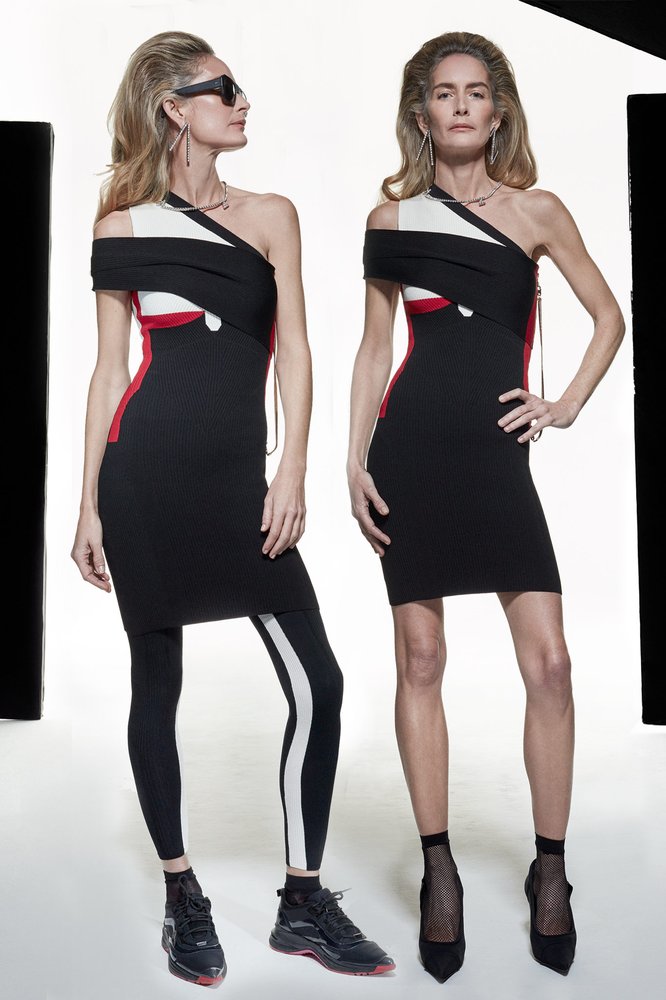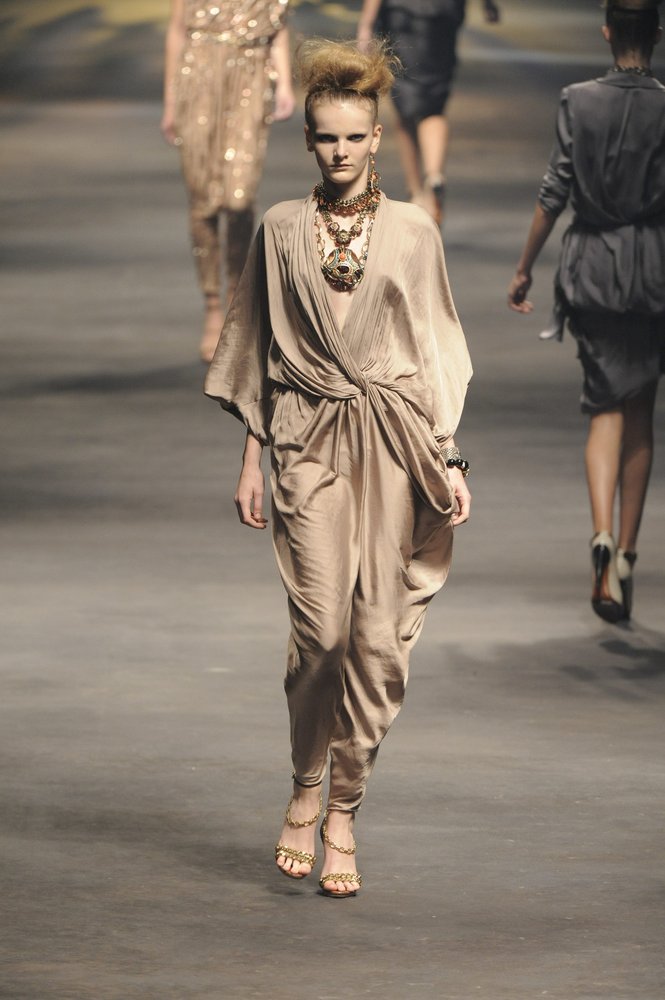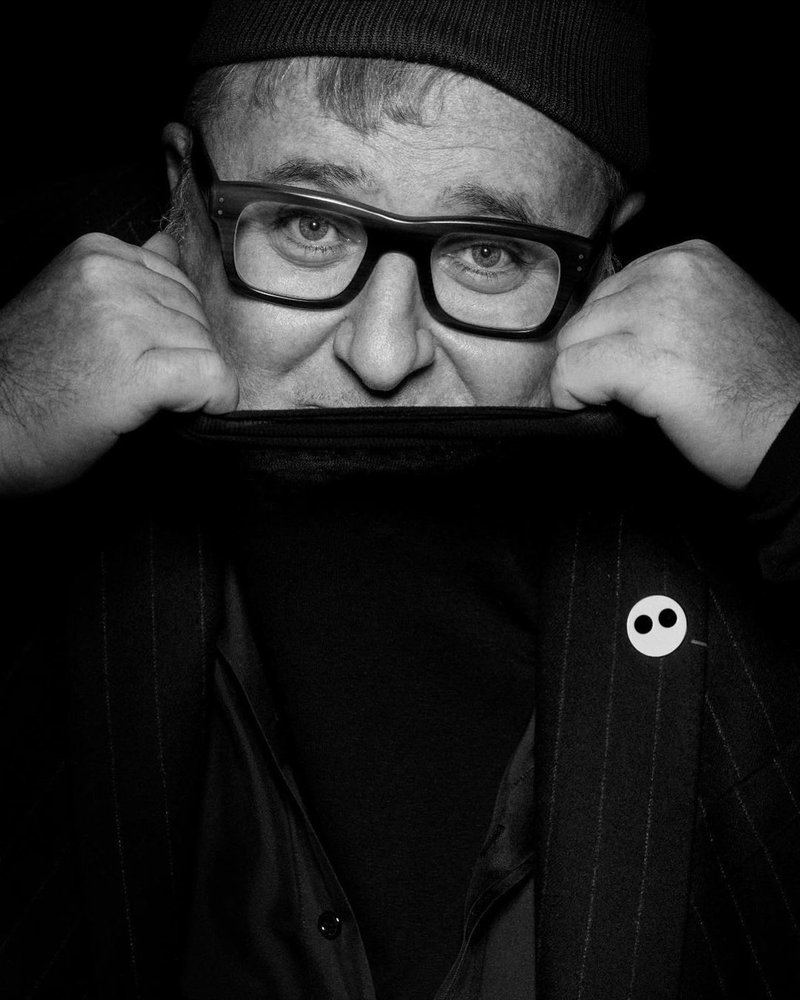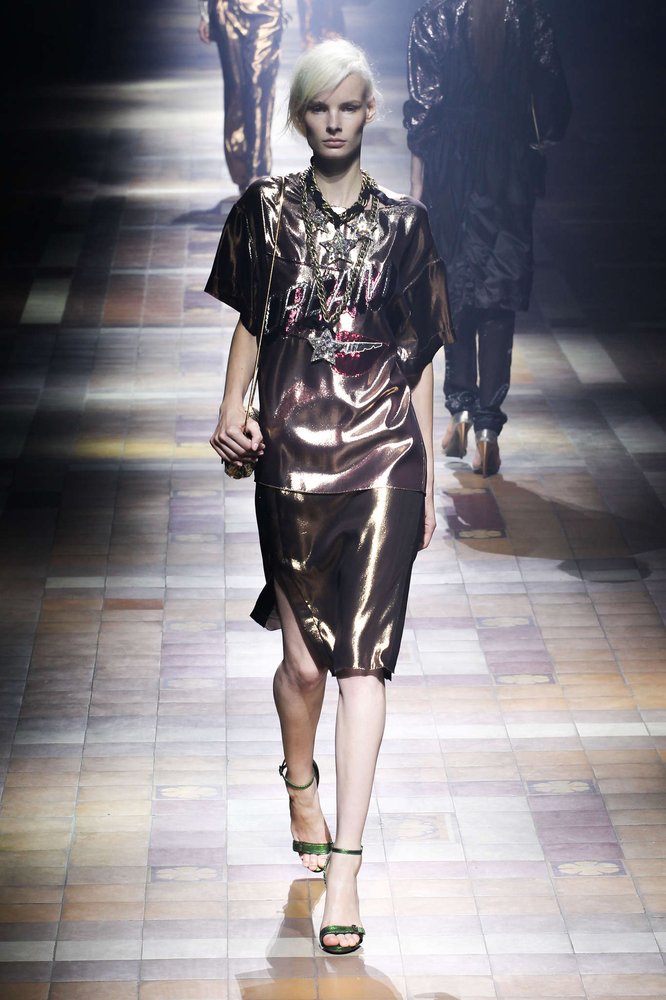Apr 25, 2021
Fashion this weekend went into mourning after the death of Alber Elbaz, one of the most universally loved
designers in the industry.

Elbaz, who died Saturday, created collections for a half dozen fashion houses including his own, though it was a 14-year tenure at Lanvin where he would write a chapter in fashion which earned him a place among the Pantheon of truly great all-time designers.
His sense of cerebral glamour, smoky sensuality and opulent luxury at Lanvin made his shows one of the half-dozen most important on the international calendar for a decade and a half. Blessed with a warm sense of irony, poetic wit and natural bonhomie, he was also one of the most popular figures in the entire industry. And in an industry that can be ruthlessly competitive and back-biting, Alber managed always to be considerate to everyone.
Elbaz, who passed aged 59, was still rising in his career, having just launched his own label AZ Factory, named after the first and last initials of his names, and financed by the luxury conglomerate Richemont. An ambitious project that seemed destined to write another exciting episode in the world of style.
He died in the Pitié-Salpêtrière hospital in Paris some three weeks after contracting Covid-19, even though he had been vaccinated twice. He had seemed to have passed the worst and be gathering strength, but then suffered a heart attack on Saturday. His funeral is expected to be in Israel on Wednesday, where he will be buried next to his parents.
Richemont is understood to be planning a memorial, though given the social distancing required by Covid-19 measures this may well not take place for several months.
Born in Casablanca in 1961, Elbaz moved as an infant to Israel with his hairdresser father and painter mother, residing in Holon, the working-class bedroom community south of Tel Aviv. An innately gifted illustrator he began drawing dresses at the age of seven; going on to study at Israel’s great fashion and design school, Shenkar College.
Shortly after graduation, Elbaz departed for New York, where he ended up being hired by Geoffrey Beene, one of America’s greatest designers, famed for using modest fabrics like sweatshirts and denim to craft stylish eveningwear. Alber liked to recall that he arrived in New York with $800 from his mother Allegria, and two suitcases, one small with his belongings and the other large with his dreams.

Alber worked seven years with the reclusive Beene’s in his 57th Street studio and showroom in Manhattan, very much under the radar, since Beene had a long-term war with the editor-in-chief of Women’s Wear Daily, John Fairchild, which led to what was then fashion’s newspaper of record banning Beene entirely from the newspaper. One day, after a presentation when Beene received a shower of compliments for a dress that Elbaz had designed from start to finish, he realized it was time to move on.
Fortunately by 1996, Elbaz was plucked from obscurity when he was appointed creative director of Guy Laroche by its visionary CEO Ralph Toledano.
“He had sent me his resume on a red paper, with his name 'Alber Elbaz' written like a logo. He clearly understood his identity and was very aware and intuitive. So I met him at the Carlyle in New York, and this short, rather fat guy shows up in red jacket, shoes and glasses and no socks… in winter! And I though, this is him. I barely needed to see his book,” recalled Toledano, today president of the Fédération de la Haute Couture et de la Mode and chairman of the Victoria Beckham brand.
Leaving Beene, Elbaz took off 10 days and arrived with the sketches for his debut collection in Paris, where they built a new studio for Guy Laroche, then a forgotten house, buying furniture at the BHV store on the rue de Rivoli.
His impact was immediate, garnering rave reviews for his combination of French chic, New York panache and Hollywood glamour.
During his debut, when a model’s heel cracked on the catwalk, she miraculously managed to elegantly make it off the stage. And, to the delight of a mortified Elbaz, the audience started clapping enthusiastically. The thunderous applause for his debut, staged inside the Carrousel du Louvre, led him to take an extended tour of his runway, beginning a rich tradition in his professional career. Looking more like a New York intellectual in his sack suit; unruly hair and wire-rimmed glasses, he clearly loved his moments of catwalk adoration.
By his second show inside the Bastille Opera, attended by his mother, WWD had put him on its cover.
Asked what she thought of the show, Allegria replied, “I didn’t see it, I was praying.”
Three years later, he was hired away by Pierre Bergé, to be the first ready-to-wear designer of the Yves Saint Laurent Rive Gauche collection, after the semi-retirement of Yves. A childhood dream for any designer, but an intensely difficult experience for Elbaz, seeing as the YSL staff practically downed tools on his arrival.
During his tenure, Yves never went to any of Alber’s Rive Gauche shows, and continued to design couture. Alber did manage to create three admirable Rive Gauche collections without ever quite reaching his creative pitch, before he was fired in 1999 when Gucci acquired YSL and installed Tom Ford as a designer.
During an 18-month sabbatical, Elbaz even designed a brilliant one-off collection for Kriza, witnessed by a mere handful of editors and buyers, before he quit that label after barely three months. Several quipping that it was his best collection for YSL.
Before reemerging at Lanvin, and marching to glory with over a score of hyper-influential collections. His earliest collections for Lanvin were lauded universally. On October 8, 2006 Fashion Wire Daily would write: “Finally, on the last day of the four-week tour of the world’s fashion capitals, a season bogged down in retro ideas, Lanvin delivered something thrillingly new.
This was one of those shows where everything came together, where the mood, music, mode and makeup all jelled in a fresh way… But what mattered most were the clothes, where a tincture of futurism, a dose of hard-edged chic and some devilishly well cut clothes made for the most important collection of the season. This Spring/Summer 2007 collection also marked a significant design turn for Lanvin’s creative director, who marched his mode into far sexier terrain. Before, Elbaz stuck to styles with a modernist Parisian elegance. Today, we witnessed a master creating edgier fare – authoritative, dark hued beauties in high-tech fabrics owning any space or room they inhabited.
“There was a thread of futurism,” Elbaz told FWD, minutes after receiving a standing ovation and the largest collective cheer of the season. “But it’s not like in the '60s or '80s when it was all about power dressing. Women have more power today. This collection was about the power of their minds.”
Elbaz would go on to stage some remarkably theatrical shows, ranging about Paris from the Opera Comique, where Bizet first performed Carmen, before settling for the Halle Freyssinet, a giant disused railway station where his beautiful cast would seem to appear out of an infinity, in a magical play of perspective. Working with show producer Etienne Rousseau, Elbaz also developed a unique overhanging gantry that gave his shows an instantly recognizable cinematic lighting. Moreover, his collections were always hyper elegantly staged, from the hand-written name tags - with just guest’s first names on the Louis XVI style chairs.
Scores of movie stars would attend his shows, as he went on to dress quite literally hundreds of actresses internationally. From Natalie Portman, Meryl Streep, Kim Kardashian and Kate Moss to Nicole Kidman, Chloé Sevigny and Sofia Coppola.
Collaborating with Lanvin’s menswear designer Lucas Ossendrijver, Elbaz also made the marque influential in menswear – using unlikely fabrics for men like duchess satin; making button-down shirts with pearls; and pairing tuxedos with jogging pants. Elbaz’s own personal style - from his gros-grain neckties and black square glasses to his preference for never wearing socks - also created a new idea of men’s style.

But it was above all for his inimitable draping and ability to create forgivingly cut Grecian columns and sublime cocktail dresses for which Elbaz will be remembered. That and his often remarkable color palette - subtly soft light pinks, violet beiges and sleek charcoals, hues one associates more with makeup than clothing.
His shows became absolute must-sees, like his remarkable fall/winter 2008 collection, made mainly in black gros grain, the ribbon armadillo like on prim, sexy nun blouses, asymmetrically draped skirts and some ravishingly well-cut cocktails.
Afterwards, a for once somber Elbaz took his bow to intense applause, just weeks after the death of his mother Allegria, to whom he jetted dozens of times that winter to visit in Israel, even sketching late at night in the hospital. A poignant reminder that class is the triumph of style over adversity.
Though he never produced a couture collection, each January during the Paris couture season, Elbaz would present the Lanvin pre-collection at morning coffee to a handful of editors and critics inside a gilded salon in the Hôtel de Crillon. It was the ultimate insiders' fashion gathering, a style tutorial where he talked his audience through each look, and one wondered if he had been a standup comic in a previous life. Like when he he recalled the last time he addressed a New York audience and explained that Lanvin had developed seven “satellite” collections. “But they all thought I had said cellulite,” he chortled.
Long before Black Lives Matter and today’s movement for inclusion, one morning in the hotel he staged another collection on an entirely black cast. Located just around the corner from Lanvin’s headquarters, the Crillon became Alber’s canteen, where I had the pleasure of lunching with him on a half-dozen occasions. Not for him the acid-tongued humor of so many ambitious designers, instead a joie de vivre and enormous respect for his colleagues and the never-ending demands for fresh ideas.
During a lecture three years ago at The Israeli Museum, he told his audience: "Clothes are always new, but the method is not. There is no industry in the world that works at such a speed, running a marathon of fashionistas running and running, including me, and not losing a single calorie in this marathon. A singer can produce eight hits a year, and no giant writer can write War and Peace in 12 different variations in one year. But in fashion, both locally here in Israel and around the world, designers are required: bigger, cheaper and faster. We're neurotic, we're surprised we're always on speed.”
Ever proud of his Israeli citizenship, he end up being the fashion Moses of his people, a champion who helped lead them into the promised land.

While at Lanvin, he even produced a collection for H&M, democratizing his otherwise pricey fashion; and received numerous awards, from the CFDA International Designer of the Year to the Legion of Honor. Success he enjoyed with his long-term partner, and the most loyal of companions, Alex Koo.
However, after multiple triumphant shows, rumors became rife of loggerheads with Lanvin’s majority owner, Taiwanese businesswoman Shaw-Lan Wang. Nonetheless it was still major shock when Elbaz was fired in October 2015. His dismissal is still regarded as one of the dumbest own-goals in luxury management, as it cut the valuation of Lanvin in two overnight in most experts’ opinion.
Post-Lanvin he was to develop a perfume with Frédéric Malle and a shoe and bag collection with Tod’s, before finding a suitable backer with Richemont to launch his own house. He debuted his new concept AZ Factory in January this year, capturing at an affordable price point his true DNA - cocktail-hour sophistication, superlative draping and the ability to enhance feminine beauty with an exotic and artistic finish.
Besides broadening his target audience, Elbaz also broke a few rules with his launch, by staging what he called “show fashion” in a mock variety TV show.
For a little va-va-vroom, a deep-gorge dress cut with bouffant shoulders and leg-of-mutton sleeves; or a perfectly judged cocktail with huge back bow. All told 11 pieces, rolled out every few weeks, fresh deliveries appearing in varying palettes of colors.
“But this is not a capsule collection, as that reminds me of antibiotics!” he quipped, in my last conversation with him, a one-to-one Zoom.

All made in XX small to XXX extra large.
“I know too many women who go to the children’s department to buy dresses! This is a solutions-orientated project,” stressed Elbaz.
He called evening looks 'Diamonds and Pearls', with black décolleté columns finished with crystal-logo necklaces and dangling earrings; or multiple necklaces of oversized pearls. His other key decision was dressing his cast in in new elongated pointy-toe pump-shaped sneakers. He called this model 'Sneaky Pumps.'
“It’s the same cook, but different ingredients in the kitchen,” he cracked.
Noted his great friend Toledano: “At least, Alber had been very happy in this moment after several very difficult years. He loved people and humanity was always front and center for him. Fashion has always been about men and women. And Alber loved them and loved to be loved. And he was loved by so many.”
In the end it is of the bitterest irony that Alber, who went into personal lockdown, observed social distancing rigidly and had bottles of jell everywhere, should have been the latest victim of this accursed pandemic. But in his career, few designers have created so much beauty, and managed to do so with such humor, tenderness and panache.
Non est ad astra mollis e terris via.

